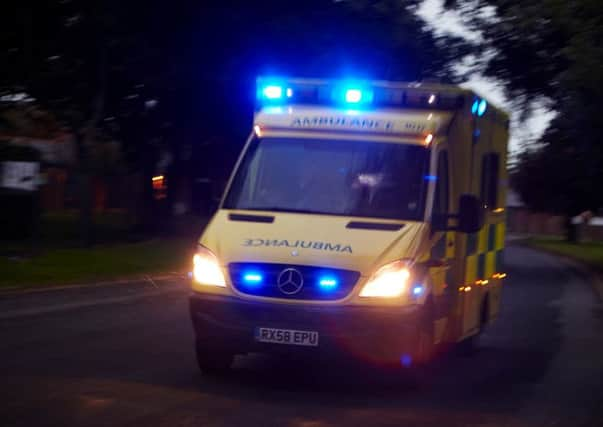999 response times in Horsham and Mid Sussex ‘worst’ in South East


Emergency response times in this area are ten per cent lower than any other part of the South East region.
Blame has been pointed at the rural geography of the districts.
Advertisement
Hide AdAdvertisement
Hide AdNow health care experts want to discuss with South East Coast Ambulance Service (SECAmb) - responsible for responding to 999 calls across Sussex, Surrey and Kent - the possibility of entering into a new contract for Sussex alone.
GPs at the Horsham and Mid Sussex Clinical Commissioning Group (CCG) believe a closer relationship with the service will benefit SECAmb’s knowledge of the rural area.
However, the move would be costly.
During the meeting on Tuesday (December 3) David King, head of performance, said: “The CCG clearly suffers the worst performance standards than others across the region - ten per cent lower across the Horsham and Mid Sussex geography.
“There are many reasons for this. The thing that’s most noticeable is the make up of our geographical area. Because we have a lot of rural areas our service suffers.”
Advertisement
Hide AdAdvertisement
Hide AdIn a CCG document entitled ‘Emergency response times deep dive’, it reports SECAmb responded to 3,655 emergency incidents categorised as life-threatening across Horsham and Mid Sussex from April to August 2013.
But only 58.05 per cent were attended within eight-minutes.
The service aims to respond to 75 per cent of its most serious calls within that time frame.
The response rate in Horsham town centre is above this target. Between April and August SECAmb attended a total of 296 serious incidents. More than 85 per cent of these were reached within eight-minutes.
It is clear, however, that on average patients in rural areas wait much longer to receive emergency treatment which can save lives.
Advertisement
Hide AdAdvertisement
Hide AdJust 18.31 per cent of Nuthurst emergencies were attended within the eight-minute time frame. Rudgwick, Ashurst Wood, High Weald, Itchingfield, Slinfold and Warnham are among the rural areas worst affected.
“The visual data is powerful,” said Simon Chandler, lay member for public and patient information, referring to the map [pictured right].
“I think that the eight-minute target is a target that is quite a long time for patients, so missing it significantly is something we need to look at.”
The CCG said performance can be influenced by a number of factors including unexpected increase in demand, severe weather and diverts between hospitals which increase journey times.
Advertisement
Hide AdAdvertisement
Hide AdBlame has also been directed at hospital handover delays. This is the amount of time it takes to officially pass the patient from SECAmb paramedics to hospital staff.
But what is the key to improving emergency response times in this area?
Sue Braysher, chief operating officer, believes a new contract with SECAmb forms part of the answer.
The current contract covers Sussex, Surrey and Kent. But the health professional said talks about drawing up a contract for Sussex alone will soon be on the table.
Advertisement
Hide AdAdvertisement
Hide AdShe said: “SECAmb is such an integral part of the care pathway that we would like to have a much more local relationship with them. We think there would be benefits to it. We have different issues because of the rural basis in Horsham.”
She also warned that SECAmb should be aware of population growth as a result of housing in the area and explained the CCG would need to look at the economies of scale.
Around £100,000 is spent annually managing the current contract. A new contract tailored for Sussex would be even more expensive. How much more is not known.
Minesh Patel stressed: “The challenge for us if we commission at a Sussex level is it’s a more costly way. Are we going to get the return in value for money and outcome? We need to put some significant thought into it.”
Advertisement
Hide AdAdvertisement
Hide AdDavid King said during the meeting that SECAmb recognises its performance. But speaking of historical discussions about improving standards, he indicated the group had made little ground.
He continued: “At the end of the day it’s for [SECAmb] to decide how best to discharge their assets.
“I’m encouraging them to go out into the community to explain how they do respond and try to get people to understand a bit better that this is a normal part of ambulance operations.”
South East Coast Ambulance Service (SECAmb) has responded to concerns over emergency response times.
Advertisement
Hide AdAdvertisement
Hide AdIt says the average response times for the Horsham and Mid Sussex region since April has been 7.13 minutes for Red 1 calls and 7.47 minutes for Red 2 calls.
A spokesperson for the service said: “SECAmb recognises the importance of response times and exceeded government targets by reaching 75.2 per cent of the most serious and life-threatening calls (Red 1 category) within eight minutes between April 2012 and March 2013.
“While response times are of course very important, what is also vital is the treatment patients receive once our clinicians arrive at the scene of an emergency. We are pleased that the government now places a greater emphasis on patient outcomes as well as response times. This is something we had been calling for for a number of years.
“Along with all parts of the NHS, SECAmb has been and continues to be extremely busy. We recognise that there can be variation in our performance in terms of response times throughout the year. While every effort is made to meet our performance targets at all times, variation can exist for reasons including challenging weather conditions, unanticipated increases in demand, or geographical differences.
Advertisement
Hide AdAdvertisement
Hide Ad“SECAmb staff are working extremely hard to meet this increase in demand and the trust is committed to providing an excellent service to our all our patients across Sussex, Surrey and Kent.”
The news comes as the Department of Health is reported to be providing £15million to ambulance services.